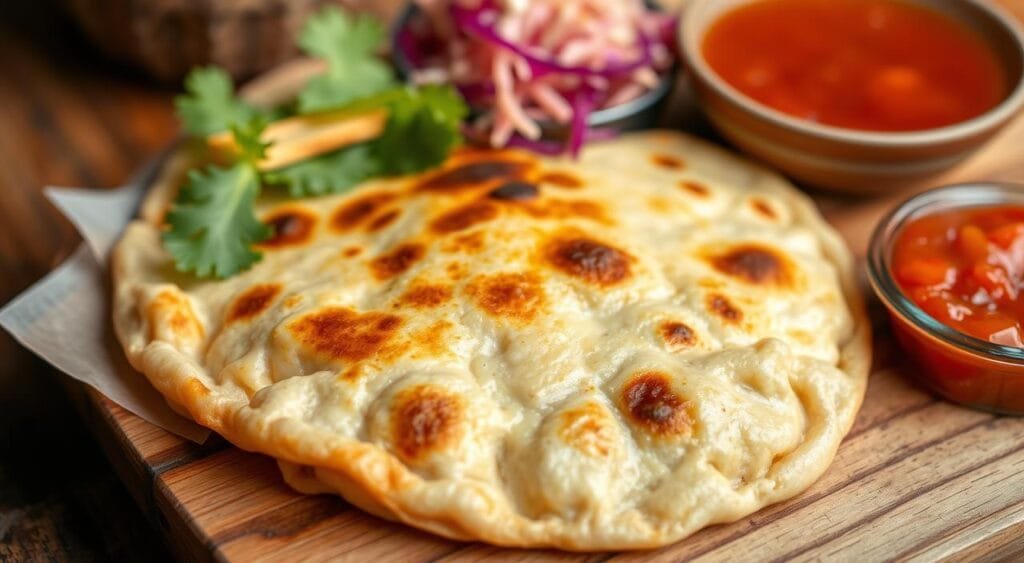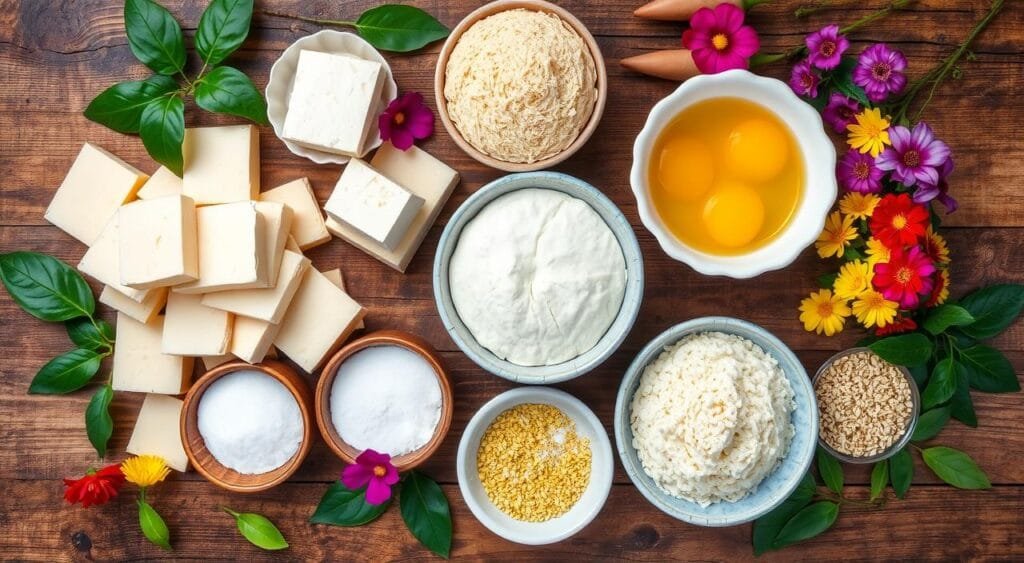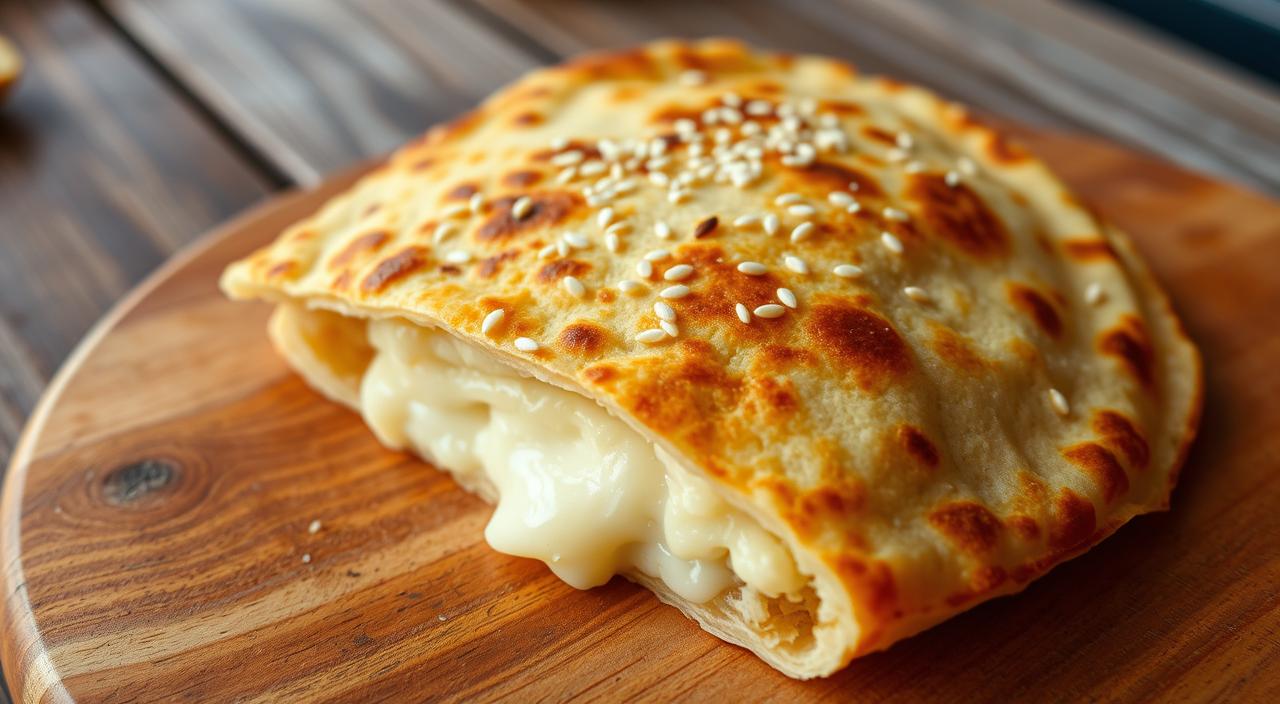As the sun rises over El Salvador’s markets, a sweet smell fills the air. This is the quesadilla salvadoreña, a gluten-free cake loved for generations. It’s a comfort food that brings joy, enjoyed with coffee in the morning or as a snack.
The quesadilla salvadoreña is more than just a treat. It’s a symbol of El Salvador’s culture and traditions. Exploring this cake, you’ll find out what makes it special in Salvadoran cuisine.
What Makes Quesadilla Salvadoreña Unique
Quesadilla Salvadoreña is different from Mexican quesadillas. It’s a sweet, cake-like bread loved on Sundays in Salvadoran homes. Rice flour and sesame seeds make it special.
Difference from Mexican Quesadillas
Mexican quesadillas are savory and flaky. But, Quesadilla Salvadoreña is sweet and cake-like. It’s enjoyed for breakfast or as a snack, offering a unique taste.
Cultural Significance in El Salvador
Quesadilla Salvadoreña is more than a tasty treat. It’s a key part of Salvadoran culture. Sold in the mornings, it’s a quick breakfast for many. Passed down through generations, it’s a cherished tradition.
Traditional Serving Occasions
Quesadilla Salvadoreña is a favorite for Sunday breakfasts. Its sweet, cake-like texture and aroma are perfect for the weekend. It’s also enjoyed as a snack or with coffee, showing its versatility.

Essential Ingredients for Authentic Flavor
Making the perfect quesadilla salvadoreña starts with choosing the right ingredients. It combines queso duro (a mix of hard and soft cheese), cuajada (milk curd), and rice flour. This mix gives it a unique taste. If you can’t find queso duro blando, Cotija or Parmesan cheese works well. Cottage cheese and queso fresco can replace cuajada.
The quesadilla salvadoreña also needs crema salvadoreña (like crème fraîche), sugar, and toasted sesame seeds for flavor. Eggs and butter make it moist. A little cinnamon adds a warm, spiced taste. Balancing these ingredients brings out the true taste of this comida centroamericana dish.

Whether you’re from El Salvador or just love to cook, making quesadilla salvadoreña is a fun adventure. Knowing how these ingredients work together lets you enjoy the real taste of this Central American treat.
Traditional Cheese Varieties and Substitutes
The heart of Quesadilla Salvadoreña is queso duro blando, a white cheese from El Salvador. It’s airy, light, and hard, giving the dish its unique flavor and texture. If you can’t find this cheese, cotija or Parmesan can be good substitutes. They offer a similar savory and crumbly taste.
Queso Duro Blando Options
Queso duro blando is a special cheese from El Salvador. It adds a rich, creamy taste and a soft yet firm texture to the dish. If you can’t find this cheese, you can mix queso fresco and cottage cheese. Or, you can use grated cotija or Parmesan cheese as a substitute.
Modern Cheese Alternatives
If you have dietary restrictions or preferences, there are modern cheese alternatives. Vegans can choose plant-based cheeses made from cashews, almonds, or soy. For a dairy-free option, you can use almond or coconut milk-based cheese substitutes.
Importance of Dairy Components
Dairy components like crema salvadoreña or regular sour cream are key in Quesadilla Salvadoreña. They add to the dish’s rich flavor and texture. These creamy elements balance the sweetness and enhance the plato callejero (street food) classic’s luxurious feel.
Step-by-Step Preparation Guide
Making the perfect antojitos, or traditional Central American snack, like the Quesadilla Salvadoreña, is a fun journey. The secret to its authentic taste and texture is in the preparation steps. Let’s explore the steps to make this beloved comida centroamericana dish.
Start by mixing cheeses like queso duro blando or Parmesan with milk and heavy whipping cream. Then, separate the egg whites and beat them until they’re stiff and fluffy. In another bowl, mix the egg yolks and sugar until it’s light and airy.
Add rice flour and melted unsalted butter to the egg yolk mix. Then, gently fold in the whipped egg whites. The batter should be thicker than pancake batter. You can make it a day ahead or bake it the same day for great results.
When the batter is ready, pour it into 6-inch round cake pans. Bake the Quesadilla Salvadoreña cakes at 350°F (177°C) for about 30 minutes. They’re done when a toothpick comes out clean. Let them cool for 15 minutes before unmolding them to keep their shape.
Follow these steps to make your own Quesadilla Salvadoreña. You’ll enjoy the authentic flavors and feel like you’re in El Salvador.
The Perfect Texture and Consistency
The secret to a great quesadilla de maíz lies in the batter. Beat the egg whites until they’re soft and fluffy. Then, mix in the sugar and egg yolks slowly. This makes the batter light and just right.
Achieving the Ideal Crumb
After mixing the egg mixture, add the rice flour and melted butter gently. The batter should be smooth and a bit thicker than pancake batter. This ensures the cake has the right texture, not too heavy or too light.
Batter Preparation Tips
It’s important to mix the ingredients in the right order and way. Whip the egg whites well, add sugar slowly, and fold in the flour and butter carefully. With practice, you’ll get the hang of making this traditional Salvadoran dish.
Baking Methods and Temperature Control
Getting the perfect quesadilla salvadoreña is all about temperature control. This traditional Salvadoran cake needs just the right heat to get it just right. Follow these baking tips to make sure your plato callejero or antojitos are a hit.
First, preheat your oven to 350°F (175°C). You can bake it in rectangular pans or muffin tins. Make sure to grease the pan well to avoid sticking. Then, add the batter and sprinkle some sesame seeds on top.
Bake for 38 to 45 minutes, watching it closely. You want it to be golden brown on the outside and soft inside. Check if it’s done by inserting a toothpick into the center. It should come out clean.
“Achieving the perfect balance of heat and baking time is essential for crafting an authentic quesadilla salvadoreña that showcases the traditional flavors of El Salvador.”
By sticking to these temperature and baking methods, you can make a delicious Salvadoran plato callejero or antojitos in your kitchen.
Nutritional Information and Health Benefits
The quesadilla salvadoreña is a favorite in Salvadoran cuisine. It’s not just tasty but also good for you. A single serving has about 169-270 calories, which is not too high.
It has 15g of fat, 29g of carbs, and 6g of protein. This mix of nutrients makes it a healthy treat.
Caloric Content and Macronutrients
This dish is special because it’s gluten-free. It’s made with rice flour, which is safe for those with gluten issues. You can also adjust how sweet it is, using just 1/2 cup of sugar for a perfect balance.
Dietary Considerations
A serving of quesadilla salvadoreña gives you 11% of your daily calcium and 3% of your iron. It’s packed with good stuff that’s part of a healthy Salvadoran cuisine diet.
Storage Tips and Shelf Life
After baking, let your pupusa cool for 10 minutes before taking it out of the pan. It’s great warm or at room temperature. For the best storage, keep it in an airtight container at room temperature for a few days. Refrigeration can also extend its life.
Salvadorans abroad often bring this cake to share with friends and family. It shows how well it keeps and how tasty it stays. With the right storage, your pupusa can stay fresh and flavorful for days.
Act fast after baking to keep your pupusa perfect. Cool it and then store it in an airtight container. This way, you can enjoy its unique taste for days. Whether you’re sharing or enjoying it alone, your pupusa will impress with its long shelf life.
Conclusion
The Quesadilla Salvadoreña is a favorite in Salvadoran cuisine. It’s loved as a tasty breakfast or snack. Its mix of cheeses, rice flour, and sesame seeds gives it a unique taste.
Exploring Salvadoran food, the Quesadilla Salvadoreña shines. It shows the country’s diverse food culture. This snack is a true taste of Central America.
Trying to make the Quesadilla Salvadoreña at home is more than a recipe. It’s a way to celebrate Salvadoran culture. Enjoy the rich flavors and share it with others. This way, you’ll appreciate El Salvador’s food even more.
FAQ
What is Quesadilla Salvadoreña?
Quesadilla Salvadoreña is a sweet, gluten-free bread from El Salvador. It’s often enjoyed with coffee for breakfast or as a snack.
How is Quesadilla Salvadoreña different from Mexican quesadillas?
Unlike Mexican quesadillas, Salvadoran quesadillas are sweet and cake-like. They are not savory folded tortillas with fillings.
What is the cultural significance of Quesadilla Salvadoreña in El Salvador?
Quesadillas are a beloved Sunday morning treat in Salvadoran homes. They are a big part of Salvadoran food culture.
What are the key ingredients in Quesadilla Salvadoreña?
The main ingredients are rice flour, queso duro blando, cuajada, crema salvadoreña, eggs, sugar, butter, and sesame seeds.
What are the traditional Salvadoran cheeses used in Quesadilla Salvadoreña, and what are good substitutes?
Queso duro blando is the traditional cheese. Cotija or Parmesan cheese work well as substitutes. You can also use a mix of cottage cheese and queso fresco for cuajada.
How is Quesadilla Salvadoreña typically prepared?
First, blend cheeses with milk and cream. Then, beat egg whites until soft peaks form. Add sugar and yolks, mix in rice flour and melted butter, and combine all ingredients.
What is the ideal texture and consistency of Quesadilla Salvadoreña?
The perfect quesadilla has a light yet dense texture. Beat egg whites until soft peaks form, then add sugar and yolks. Fold in flour and melted butter carefully.
How is Quesadilla Salvadoreña baked?
Bake in rectangular pans or muffin tins. Pour the batter into a greased dish, sprinkle with sesame seeds, and bake at 350°F (175°C) for 38-45 minutes.
What are the nutritional benefits and dietary considerations of Quesadilla Salvadoreña?
A serving has about 169-270 calories, 15g fat, 29g carbs, and 6g protein. It’s a good source of calcium and iron. It’s gluten-free because of rice flour.
How should Quesadilla Salvadoreña be stored and how long does it last?
Store in an airtight container at room temperature for a few days. You can also refrigerate it. Many Salvadorans take it back home to share, showing it’s great for keeping and sharing.
